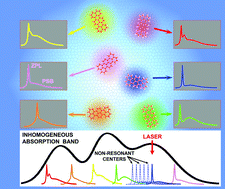We present a technique for the measurement of the low-temperature fluorescence excitation spectra and imaging of a substantial fraction of all single chromophore molecules (hundreds of thousands and even more) embedded in solid bulk samples as nanometre-sized probes. An important feature of our experimental studies is that the full information about the lateral coordinates and spectral parameters of all individual molecules is stored for detailed analysis. This method enables us to study a bulk sample in a broad spectral region with ultimate sensitivity, combining excellent statistical accuracy and the capability of detecting rare events. From the raw data we determined the distributions of several parameters of the chromophore spectra and their variations across the inhomogeneous absorption band, including the frequencies of the electronic zero-phonon lines, their spectral linewidths, and fluorescence count rates. Relationships between these distributions and the disorder of the matrix were established for the examples of two polycrystalline solids with very different properties, n-hexadecane and o-dichlorobenzene, and the amorphous polymer polyisobutylene. We also found spatially inhomogeneous distributions of some parameters.

You have access to this article
 Please wait while we load your content...
Something went wrong. Try again?
Please wait while we load your content...
Something went wrong. Try again?


 Please wait while we load your content...
Please wait while we load your content...